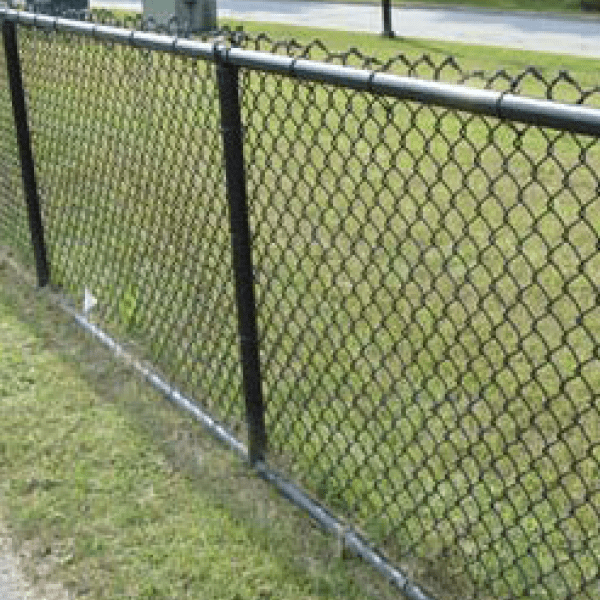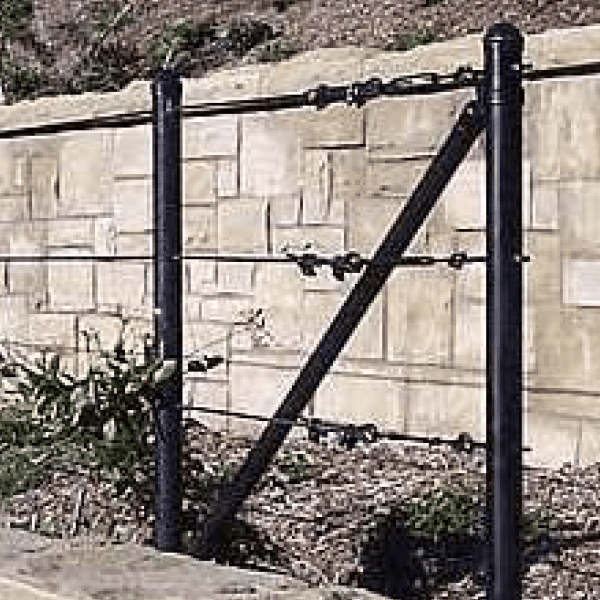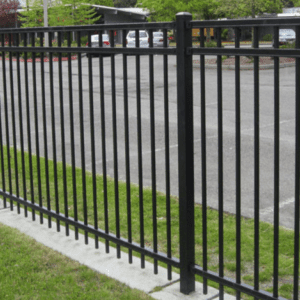Fencing is used to limit access to areas around the greenway.
It can also be used where a significant safety concern requires the use of a taller barrier than an handrail alone.
- Fence posts should be set in concrete footings, never surface mounted.
- Fences can vary in height, depending on the situation, from 3’-6” to 8’-0” depending on application.
- Fences are typically designed to limit access and to cover significant area. They are typically less rigid than handrails.
- Allow 3” clear from the bottom of the panel or pickets to the ground for ease of mowing.
- Fences or barriers placed within flood prone and/or stormwater overtopping and conveyance paths may catch floating debris and must be evaluated for adequacy by hydrologic and hydraulic analysis (also see recommended cable fencing for flood prone areas).
Environmental Graphics
Fences provide a valuable opportunity for the installation of visual elements that elevate brand awareness, enhance user experience and communicate interpretive messages. Great Rivers Greenway has created an environmental graphics toolkit that contains various designs and elements that can be considered during the planning and design process.
ORNAMENTAL FENCE – PREFERRED FENCE
Ornamental fencing has high aesthetic value, and most systems allow for easy installation along variable slopes, making them preferable for following alongside the trail. Only high quality commercial grade fence should be utilized.
- Openings between balusters to be less than 4”.
- One top rail and one bottom rail standard, more can be added for aesthetics.
- Opening between bottom of baluster/rail and finish grade to be less than 4”
- Powdercoated Aluminum or Steel.
- Black.
- Where appropriate and where cost allows, a concrete base may be added (like in image to the left) for reduced maintenance in turf areas.
BEST USE AREAS: High visibility areas, where higher cost less of a concern.
PROS: Standard product. Readily Available. Works well with slopes. Available in a variety of styles.
CONS: High cost.
Construction details for the preferred ornamental fence
WELDED WIRE PANEL
Welded wire fencing is a good option for perimeter fencing for large areas. Fence panels are self supporting, with posts as the only other structural members. Welded wire fence has a more refined look that standard chainlink, but is much more cost effective that ornamental fencing.
- 2”x 4” self supporting wire mesh grid attached to posts with brackets.
- Powdercoated or vinyl coated steel.
- Black.
BEST USE AREAS: Long runs on relatively flat areas where panels can be used square, without cutting. Can be used in high visibility areas.
PROS: Low cost, but more refined look than chainlink. Self supporting panels require much less install time than chainlink. Double wire panels are available and very rigid for higher protection need.
CONS: Panels must be cut to follow slopes, exposing ends to rust.
 VINYL-COATED CHAIN LINK
VINYL-COATED CHAIN LINK
Vinyl coated chain link is a low-cost option for long runs of fencing. It is best used in less visible areas, where it is expected to blend into the surroundings. Since panels are not self supporting, at a minimum bottom rails should be installed. Mid rails may be required for taller fences.
- Standard 2” x 2” opening.
- Opening between bottom of chain link and finish grade to be less than 4”.
- Gap between Chain link fence material and post to bes less than 4”.
- Decorative cap on post.
- Bottom rail is preferred to cabling or stretcher bar.
- Black.
BEST USE AREAS: Background, where fencing is expected to blend in. On variable slopes. Locations where dense vegetation will screen the fence.
PROS: Low Cost. Flexible on variable terrain. Blends into surroundings.
CONS: Low aesthetic value. Requires most installation time. Not rigid.
 CABLE FENCE
CABLE FENCE
This type of fence is typically used as a pedestrian barrier in locations where flooding is frequent. The cable fence does not typically collect flood debris as readily as a chain link fence.
- Typically 3 to 4 cable rails, spacing between rails ranges from 10.5” to 14”.
- Galvanized steel braided cable between black vinyl coated steel posts.
BEST USE AREAS: Locations where flooding is frequent.
PROS: In areas of flooding, gaps between rails allow debris to flow through. Reasonable cost. Low visual impact.
CONS: Maintenance after flooding events to ensure fence is free of debris. Cannot be used as a guardrail to prevent falls due to wide openings between rails.


